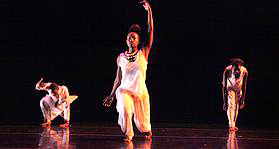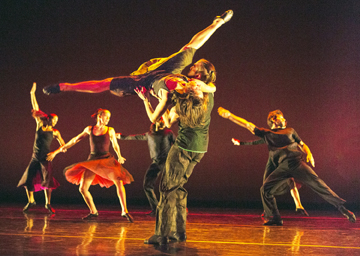Dance: Three at The Joyce: Evidence, Malpaso, Compagnie CNDC-Angiers
By Dawn Lille
ART TIMES Summert 2015
 Evidence Dance Company Subtle” |
The Joyce Theater, on 8th Avenue and 19th Street, is a 472-seat venue for dance that is the result of a 1982 conversion of the Elgin Movie Theater. It showcases multiple types of dance from all over the world 52 weeks of the year and also commissions new work. The month of March saw three companies in succession.
Evidence, A Dance Company, was founded in Brooklyn thirty years ago by Ronald K. Brown, its Artistic Director. He says they focus on “the fusion of African dance with contemporary choreography and spoken word.” His work uses movement to reinforce community in African American culture, but he is also a storyteller whose subtle narratives are told through movement.
What is different about Brown’s dancers is that when they use their bodies in his loose, amoeba-like manner, that is all lushness one moment and the next is punctuated by sudden, quick movements of an arm or leg, they are able to communicate the full range of human feelings. One is never sure how they send different emotions out to the audience, but even their sorrow leaves the viewer with a sense of joy. The richness of movement in a relaxed body interrupted by spasmodic jabs – sometimes the whole body jumping up and folding in half with anxious beats of the feet in the air – develops an awareness in the observer.
Evidence presented two programs with a total of eight different pieces. The Subtle One, with music by Jason Moran, is based on a quote from Alan Harris, “ So subtle are the wings of angels.” Here the company of nine, including Mr. Brown, seemed to be the galaxy, sometimes a constellation, creating an other worldliness that could pull you out of your seat.
Through Time and Culture was described as being about transition and perspective, but it seemed to really be about the former. Since it was a rare solo for Brown, with his open chest and outstretched arms, it was easy to assume he was saying, “I’ll make it whatever comes.”
Grace , to music by Duke Ellington, Roy Davis, Jr. and Fela Anikulapo Kuti, was created in 1999 for the Alvin Ailey Company and taken into Evidence in 2003. It is about a goddess journeying to earth to spread grace and then welcoming humans to heaven. In its openness and humanity it becomes a beautiful gesture of spirituality.
 Malpaso Dance Company “Under Fire” (Photo) Yi-Chun Wu. |
Last year Brown was commissioned by the Joyce Theater to choreograph a dance for Malpaso, a new contemporary Cuban dance company. The Cubans danced Why You Follow/Por Que Siques last year in their New York debut. I missed that performance but was delighted to see Evidence filling the stage with it this year. To four different African related songs in sections labeled Open Heart, Commitment, The Path and Faithfully Forward, the dancers tore up the stage. Sometimes they communicated with each other. Other times they enveloped the audience in movements that clearly traveled from hip to leg to arm and then somewhere through space.
This was a wonderful gift to Malpaso, which probably danced it differently but with no less fervor, and it provided an interesting bridge into the company from Cuba, which was the next performing group at the Joyce.
Just two years old, Malpaso translates as “misstep” or “out of step” and they are one of the few independent (e.g. not government supported) modern dance companies in Cuba. Their mission is to update and develop the chorographic world within the country by means of what the Executive Director, Fernando Saez, terms “conversations” with world recognized choreographers. This is accomplished by performing their works. They describe themselves as “ … a collaborative experience in contemporary dance” and hope to be the leaders in developing a new generation of Cuban choreographers.
This year the Joyce commissioned Trey McIntyre, originally from Idaho, where he had his own company, but now a freelance choreographer, to create a work for the company. The program note for his piece Under Fire spoke of burning away the exterior of ourselves so that our essential being can come through. Set to songs by Grandma Kelsey, it showcased the company’s strong dancers, with their sureness in reaching into space. There was a wonderful sense of male/female equality as the work developed incrementally, revealing more of the dancers as individuals and in relationships. But there was nothing to reveal their essential Cuban personalities.
The second work on the program was Despedida/Farewell, choreographed by Osnel Delgado, the young Artistic Director of the company, in collaboration with the dancers. The music, by Arturo O’Farrill, was played live by his Afro Latin Jazz Ensemble. Based on a poem by Jorge Luis Borges and danced by the entire company, including Delgado, the movements required full use of the body with a very flexible torso and had its participants constantly crossing paths. But, on an initial viewing, it did not seem to adhere to the loss of love in the poem and had little relationship to the rhythms of the music.
As the beginning of a company with a new goal for contemporary dance in Cuba, Malpaso leaves much to look forward to. If it can help develop and support new Cuban choreographers able to express their unique culture, the dance world will be richer.
 “Event” Compagnie CNDC – Angiers (Photo: Patrick André) |
Malpaso was followed by Compagnie CNDC – Angiers, the resident dance company at the Centre National de Danse Contemporaine – Angers. Created in 2013 by Robert Swinston, who was a leading dancer with the Merce Cunningham Dance Company and in 1992 became assistant to the choreographer, this very young French group performs Swinton’s choreography, as well as his staging and adaptation of Cunningham’s work.
When Cunningham died in 2009 his will, known beforehand, stated that his company was to tour for two years and then dissolve. Swinton was Director of Choreography for the tour, so it seems fitting that the most influential modern choreographer of the 20th and 21 st centuries should emerge in a slightly different manner on a new generation of French dancers. In a sense this was related to the transmigration between the two previous companies at the Joyce.
At their performance the first thing seen by the dancer filled audience was the backdrop by Jackie Matisse. All around the stage, from ceiling to floor, hung wide strips of gently swaying fabric in myriad colors embossed with randomly embossed black shapes. In contrast, the dancers wore light gray tights and sleeveless tunic tops in a black print over gray.
Into this airy space, with its positive karma, the dancers, four men and four women, came out one by one. Each pointed a foot forward, ending in a wide fourth position facing a different way on a slightly diagonal line.
The excerpts from eleven different works that Swinton put together to create what was simply termed “Event” contained everything from the entire company on stage to solos, trios and many duets. The music by John King and Gelsey Bell was performed live by them, she using her voice. Although it was created independently from the dance, following Cunningham’s method of working, there were more moments of drama and distinct rhythm here than was usually the case with Cunningham. This was a rewarding performance.
Cunningham’s work, still among the most intellectual and influential in the world, not only of dance but of the philosophy of art, looks different on these French dancers than it did on his own company. In part this is due to the fact that they do not have years of training in his technique. But they are different individuals with different backgrounds and we live in a constantly changing artistic era, where the American affinity for abstraction is not always prevalent in other cultures.
His constant exploration of how the body moves through time and space was prevalent, albeit in a different way, in these accomplished dancers. One cannot help but wonder how the work of Merce Cunningham would look on Evidence or Malpaso.
dawnlille@aol.com
